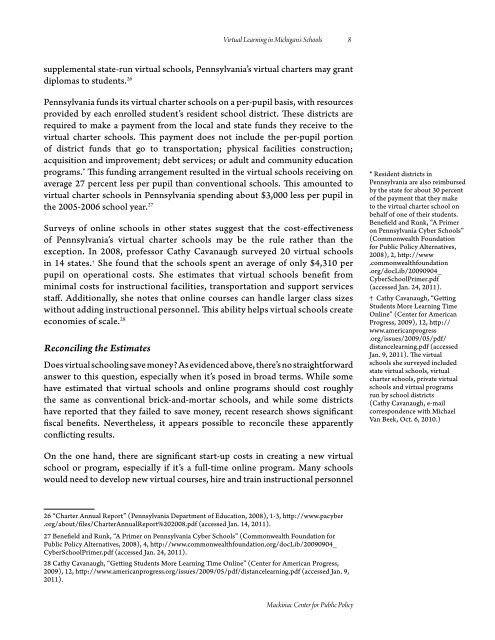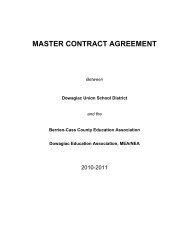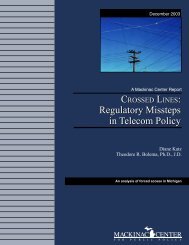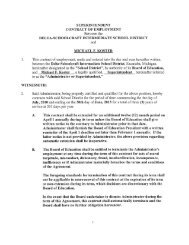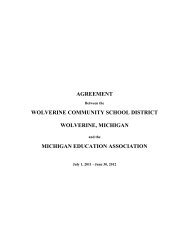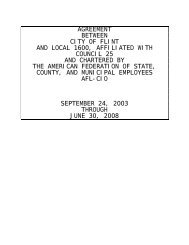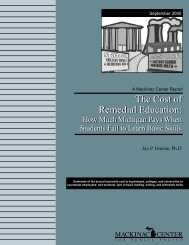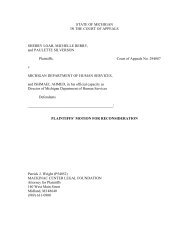<strong>Virtual</strong> Learning in <strong>Michigan</strong>’s Schools 8supplemental state-run virtual schools, Pennsylvania’s virtual charters may grantdiplomas to students. 26Pennsylvania funds its virtual charter schools on a per-pupil basis, with resourcesprovided <strong>by</strong> each enrolled student’s resident school district. These districts arerequired to make a payment from the local and state funds they receive to thevirtual charter schools. This payment does not include the per-pupil portionof district funds that go to transportation; physical facilities construction;acquisition and improvement; debt services; or adult and community educationprograms.* This funding arrangement resulted in the virtual schools receiving onaverage 27 percent less per pupil than conventional schools. This amounted tovirtual charter schools in Pennsylvania spending about $3,000 less per pupil inthe 2005-2006 school year. 27Surveys of online schools in other states suggest that the cost-effectivenessof Pennsylvania’s virtual charter schools may be the rule rather than theexception. In 2008, professor Cathy Cavanaugh surveyed 20 virtual schoolsin 14 states. † She found that the schools spent an average of only $4,310 perpupil on operational costs. She estimates that virtual schools benefit fromminimal costs for instructional facilities, transportation and support servicesstaff. Additionally, she notes that online courses can handle larger class sizeswithout adding instructional personnel. This ability helps virtual schools createeconomies of scale. 28Reconciling the EstimatesDoes virtual schooling save money? As evidenced above, there’s no straightforwardanswer to this question, especially when it’s posed in broad terms. While somehave estimated that virtual schools and online programs should cost roughlythe same as conventional brick-and-mortar schools, and while some districtshave reported that they failed to save money, recent research shows significantfiscal benefits. Nevertheless, it appears possible to reconcile these apparentlyconflicting results.* Resident districts inPennsylvania are also reimbursed<strong>by</strong> the state for about 30 percentof the payment that they maketo the virtual charter school onbehalf of one of their students.Benefield and Runk, “A Primeron Pennsylvania Cyber Schools”(Commonwealth Foundationfor Public Policy Alternatives,2008), 2, http://www.commonwealthfoundation.org/docLib/20090904_CyberSchoolPrimer.pdf(accessed Jan. 24, 2011).† Cathy Cavanaugh, “GettingStudents More Learning TimeOnline” (Center for AmericanProgress, 2009), 12, http://www.americanprogress.org/issues/2009/05/pdf/distancelearning.pdf (accessedJan. 9, 2011). The virtualschools she surveyed includedstate virtual schools, virtualcharter schools, private virtualschools and virtual programsrun <strong>by</strong> school districts(Cathy Cavanaugh, e-mailcorrespondence with <strong>Michael</strong><strong>Van</strong> <strong>Beek</strong>, Oct. 6, 2010.)On the one hand, there are significant start-up costs in creating a new virtualschool or program, especially if it’s a full-time online program. Many schoolswould need to develop new virtual courses, hire and train instructional personnel26 “Charter Annual Report” (Pennsylvania Department of Education, 2008), 1-3, http://www.pacyber.org/about/files/CharterAnnualReport%202008.pdf (accessed Jan. 14, 2011).27 Benefield and Runk, “A Primer on Pennsylvania Cyber Schools” (Commonwealth Foundation forPublic Policy Alternatives, 2008), 4, http://www.commonwealthfoundation.org/docLib/20090904_CyberSchoolPrimer.pdf (accessed Jan. 24, 2011).28 Cathy Cavanaugh, “Getting Students More Learning Time Online” (Center for American Progress,2009), 12, http://www.americanprogress.org/issues/2009/05/pdf/distancelearning.pdf (accessed Jan. 9,2011).Mackinac Center for Public Policy
<strong>Virtual</strong> Learning in <strong>Michigan</strong>’s Schools 9to deliver or facilitate instruction in a new way, maintain a reliable and robustnetwork, purchase computer hardware and software, provide office space foronsite personnel and obtain room to store and house equipment. 29 These initialexpenses may drive the projected costs for virtual schools and programs up tothe level of traditional face-to-face programs in conventional brick-and-mortarschools.On the other hand, virtual learning also has potential to reduce costs over time,and evidence from Florida and Pennsylvania suggests that both state virtualschools and virtual charter schools can operate at a lower per-pupil cost thanconventional schools. These schools probably benefit from forgoing many ofthe extracurricular and school support services that brick-and-mortar schoolsprovide, and from economies of scale in pupil-instructor ratios and overheadexpenses. Of course, estimated cost savings for virtual schools and programsshouldn’t be assumed to apply to all students. Some children may not learn wellin online environments, and the support services and extracurricular offeringsthat conventional schools provide may be of real value to them. Yet the researchdoes suggest that many pupils can benefit from virtual learning, and that thesavings in operating costs can be substantial over time.<strong>Virtual</strong> Learning in <strong>Michigan</strong><strong>Michigan</strong> has a state virtual school, two virtual charter schools, several multidistrictvirtual programs, and a host of smaller, single-district online programsand schools. The state has traditionally been seen as a national leader in virtuallearning. <strong>Michigan</strong> <strong>Virtual</strong> School was one of the first state virtual schoolsin the country. As recommended <strong>by</strong> former State Superintendent of PublicInstruction Tom Watkins in 2005, 30 Gov. Jennifer Granholm in 2006 signedinto law a requirement that high school students take at least “[one] course orlearning experience that is presented online” in order to graduate. * Althoughseveral states now offer more online learning opportunities than <strong>Michigan</strong>, theCenter for Digital Education ranked <strong>Michigan</strong> second in the nation in onlinelearning in 2008. 31<strong>Michigan</strong> <strong>Virtual</strong> SchoolThe centerpiece of <strong>Michigan</strong>’s early efforts to offer online learning opportunitiesis the <strong>Michigan</strong> <strong>Virtual</strong> School (sometimes referred to <strong>by</strong> its original name,<strong>Michigan</strong> <strong>Virtual</strong> High School). It opened in 2000, when the state Legislatureappropriated $15 million to the private, nonprofit <strong>Michigan</strong> <strong>Virtual</strong> <strong>University</strong> todevelop and operate the school. †MVS offers courses to middle school and high school students through remoteteacher online and Internet-based instruction, some of which involves an onlineMVS facilitator. MVS directly employs its own remote instructors and facilitators,* MCL § 380.1278a(1)(b)(i). An “online learning experience”is defined <strong>by</strong> the <strong>Michigan</strong>Department of Education as20 hours of activities in whichstudents “practice using technologytools, explore the virtuallearning environment, and developa competency operating inthis space.” See “<strong>Michigan</strong> MeritCurriculum Guidelines: OnlineExperience” (<strong>Michigan</strong> Departmentof Education), 7-8,goo.gl/LGEK0 (accessedJan. 17, 2011).† MVU is funded <strong>by</strong> state andfederal grants. It also operates anumber of “career developmenttools” for students, and it oversees“<strong>Michigan</strong> LearnPort,” anonline professional developmentprogram for any employee of aconventional, charter or nonpublicschool in <strong>Michigan</strong>. <strong>Michigan</strong>LearnPort is largely funded<strong>by</strong> federal grants. “Report tothe <strong>Michigan</strong> Department ofEducation on the Developmentand Growth of the <strong>Michigan</strong><strong>Virtual</strong> High School, 1999-2005”(<strong>Michigan</strong> <strong>Virtual</strong> <strong>University</strong>,2005), 6, goo.gl/UEFUC; “A Reportto the Legislature” (<strong>Michigan</strong><strong>Virtual</strong> <strong>University</strong>, 2010),1, 8, goo.gl/CKD0R (accessedJan. 12, 2011).29 Anderson, Augenblick, andDeCesare, “Costs and Fundingof <strong>Virtual</strong> Schools” (APAConsulting, 2006), 10,goo.gl/VDbqv (accessedJan. 11, 2011).30 Tom Watkins, “ExploringE-Learning Reforms for<strong>Michigan</strong>: The New Education(R)Evolution” (Wayne State<strong>University</strong>, 2005), 50, goo.gl/aYS0d (accessed Jan. 17, 2011).31 “<strong>Michigan</strong> Ranks Secondin U.S. For Online Learning”(<strong>Michigan</strong> Department of Education,2008), goo.gl/KP3iz (accessedSept. 23, 2010); Watsonet al., “Keeping Pace with K-12Online Learning: An AnnualReview of Policy and Practice”(Evergreen Education Group,2010), 18-20, goo.gl/jDwts (accessedJan. 9, 2011).Mackinac Center for Public Policy


